The Jatiluwih Rice Terraces are a UNESCO World Heritage Site located in Bali, Indonesia. They are one of the most beautiful and iconic rice terraces in the world, and they offer visitors a glimpse into the traditional farming practices of the Balinese people.
The terraces were built over centuries by the Balinese people, and they are a testament to their ingenuity and hard work. The terraces are irrigated by a complex system of canals and dams, and they are planted with a variety of rice varieties.
The rice is harvested twice a year, and it is a major source of income for the local farmers.
Introduction to Jatiluwih Rice Terraces
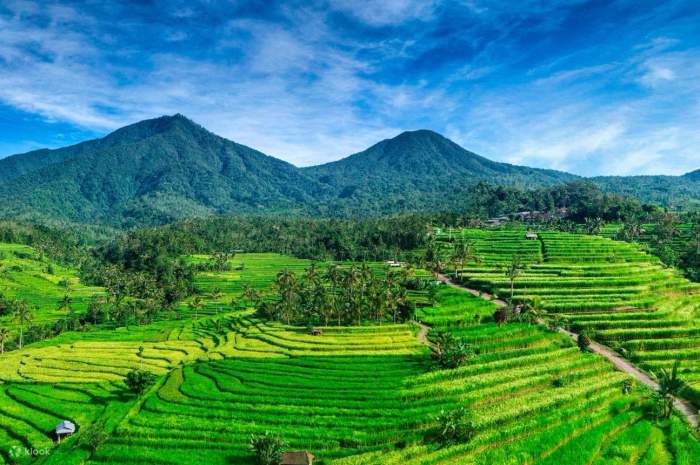
Jatiluwih Rice Terraces are located in the Tabanan Regency of Bali, Indonesia. They are a UNESCO World Heritage Site and are considered one of the most beautiful rice terraces in the world. The terraces are made up of over 1,000 hectares of rice paddies that are carved into the slopes of Mount Batukaru.The Jatiluwih Rice Terraces are a testament to the ingenuity and hard work of the Balinese people.
The terraces were built over centuries by hand, and they require constant maintenance to keep them in good condition. The terraces are a vital part of the Balinese economy, as they provide rice for the local population and for export.
Cultural and Historical Importance
The Jatiluwih Rice Terraces are not only a beautiful sight, but they are also of great cultural and historical importance. The terraces are a symbol of the Balinese people’s connection to the land and their dependence on rice cultivation. The terraces are also a source of pride for the Balinese people, and they are often featured in traditional ceremonies and festivals.The Jatiluwih Rice Terraces are a reminder of the importance of rice cultivation in Balinese culture.
Rice is the staple food of the Balinese people, and it is used in a variety of dishes. The terraces are also a source of income for many Balinese families, and they help to support the local economy.
Unique Characteristics of the Terraces

Jatiluwih Rice Terraces are not just ordinary rice fields; they are a testament to the ingenuity and agricultural expertise of the Balinese people. The terraces exhibit several unique characteristics that set them apart from other rice-growing regions in the world.
Subak Irrigation System
One of the most remarkable features of Jatiluwih is its intricate irrigation system, known as “subak.” This traditional water management system has been passed down through generations and plays a crucial role in sustaining the terraces. The subak system involves a network of canals, dams, and water temples that distribute water equitably to each farmer’s plot.
The water is sourced from the nearby mountains and flows down through the terraces, providing a constant supply of fresh water for the rice plants.
Intricate Patterns and Shapes
Another unique characteristic of Jatiluwih is the intricate patterns and shapes of the terraces. The terraces are laid out in a series of stepped contours, creating a mesmerizing patchwork of green and gold. The shapes vary from rectangular to curvilinear, and some terraces even feature intricate carvings and designs.
This diversity of shapes not only adds to the aesthetic beauty of the terraces but also serves practical purposes, such as maximizing sunlight exposure and minimizing erosion.
Traditional Farming Practices, Jatiluwih rice terraces
The farming practices used in Jatiluwih are also unique and have been passed down through generations. The farmers use traditional tools and techniques, such as wooden plows and hand-held sickles. They also adhere to traditional planting and harvesting cycles, which are based on the lunar calendar.
These traditional practices not only preserve the cultural heritage of the region but also contribute to the sustainability of the terraces.
Tourism and Conservation
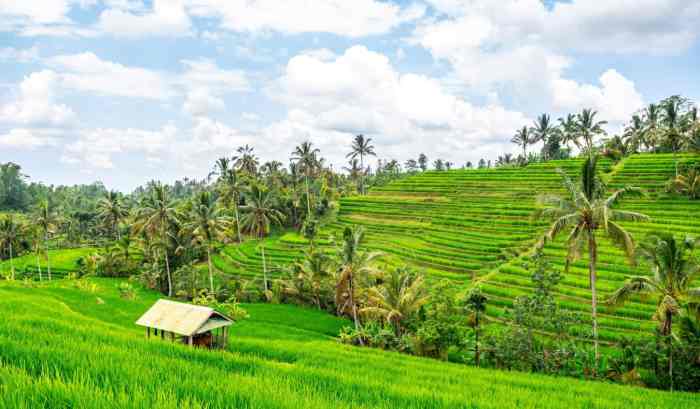
Tourism has played a significant role in promoting the Jatiluwih Rice Terraces as a UNESCO World Heritage Site. The influx of visitors has brought attention to the beauty and cultural significance of the terraces, leading to increased recognition and appreciation.
This recognition has contributed to the preservation and conservation efforts for the area.
The Jatiluwih Rice Terraces in Bali, Indonesia, are a stunning sight to behold. The lush green terraces cascade down the hillsides, creating a breathtaking panorama. If you’re looking for a similar experience in a different part of the world, consider visiting South Korea.
South Korea’s rice terraces are just as beautiful as those in Bali, and they offer a unique opportunity to learn about Korean culture and history. After exploring South Korea’s rice terraces, be sure to return to Jatiluwih to experience the beauty of these UNESCO World Heritage-listed terraces firsthand.
However, tourism also presents challenges to the preservation of the terraces. The increased foot traffic and construction of tourist facilities can impact the delicate ecosystem and cultural landscape. To address these challenges, strategies have been implemented to balance tourism development with conservation.
Sustainable Tourism Practices
Sustainable tourism practices have been adopted to minimize the environmental impact of tourism. These practices include:
- Limiting the number of visitors allowed in certain areas
- Establishing designated trails and viewpoints to prevent erosion
- Encouraging the use of eco-friendly transportation and accommodation
Community Involvement
Community involvement is crucial for the long-term preservation of the Jatiluwih Rice Terraces. Local communities are actively involved in tourism management and decision-making processes. This ensures that the terraces are managed in a way that respects the cultural heritage and traditions of the area.
Environmental Education
Environmental education programs are conducted to raise awareness about the importance of protecting the terraces. These programs educate visitors and local communities about the unique ecosystem and cultural significance of the area. By promoting understanding and appreciation, these programs encourage responsible tourism practices and foster a sense of stewardship for the terraces.
Cultural Significance
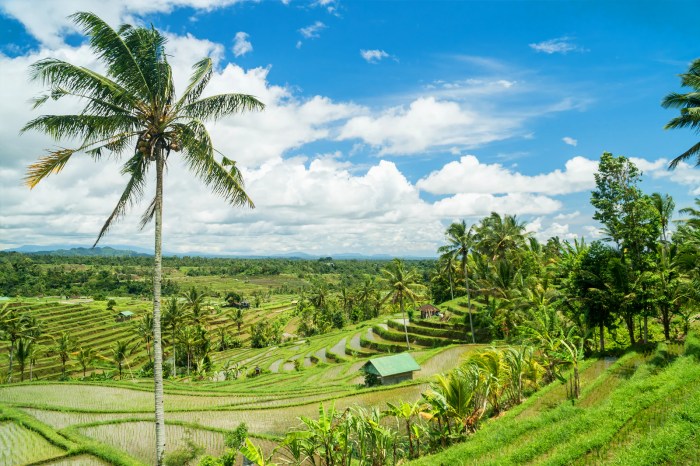
The Jatiluwih Rice Terraces hold immense cultural significance for the local community. They represent the embodiment of Bali’s agricultural heritage and are deeply intertwined with the island’s religious beliefs and traditions.
Jatiluwih Rice Terraces, a UNESCO World Heritage Site, boasts breathtaking views of verdant rice paddies cascading down the hillsides. While exploring this natural wonder, consider a visit to the nearby Penglipuran Village , a traditional Balinese village known for its unique architecture and cultural heritage.
Returning to Jatiluwih Rice Terraces, marvel at the intricate irrigation system that sustains these verdant fields, a testament to the ingenuity and dedication of local farmers.
Rice cultivation in Bali is not merely a livelihood but a sacred act. The Balinese people believe that rice is a gift from the gods, and its cultivation is a way of honoring them. The terraces themselves are seen as temples, and the farmers who tend them are considered priests.
Rituals and Ceremonies
The Jatiluwih Rice Terraces are the setting for a number of important rituals and ceremonies throughout the year. These ceremonies include:
- Subak Puja: A ceremony held to ask for the gods’ blessing on the rice crop.
- Mekotek: A ceremony held to celebrate the first harvest of the season.
- Ngaben: A cremation ceremony for the deceased, which is often held in the rice terraces.
Role in Balinese Mythology and Folklore
The Jatiluwih Rice Terraces also play an important role in Balinese mythology and folklore. They are said to be the home of the rice goddess, Dewi Sri. According to legend, Dewi Sri descended from heaven and taught the Balinese people how to cultivate rice.
The terraces are also featured in many Balinese folktales. One popular tale tells the story of a young farmer who was so poor that he could not afford to buy rice. One day, he went to the rice terraces and prayed to Dewi Sri for help.
Dewi Sri appeared to him and gave him a handful of rice seeds. The farmer planted the seeds, and they grew into a bountiful harvest. The farmer was so grateful that he built a temple in Dewi Sri’s honor.
Design and Architecture

Jatiluwih Rice Terraces showcase an intricate and ingenious design, reflecting the collective wisdom and skill of generations of Balinese farmers. The terraces are meticulously constructed and maintained, adhering to specific principles that ensure their functionality and longevity.
Construction Principles
- Contour Lines:The terraces follow the contours of the landscape, creating a series of stepped platforms that minimize erosion and maximize water retention.
- Subak System:Water management is crucial, and the terraces are interconnected by a sophisticated irrigation system called “subak.” This system channels water from higher elevations to lower ones, ensuring an equitable distribution of water.
- Stone Walls:The terraces are bordered by stone walls, which prevent soil erosion and provide structural support. The stones are carefully stacked without mortar, relying on gravity and the weight of the soil to hold them in place.
- Soil Management:The soil in the terraces is a mixture of volcanic ash, clay, and organic matter. This composition allows for good drainage and fertility, essential for rice cultivation.
Engineering Marvels
The construction of the Jatiluwih Rice Terraces required exceptional engineering skills. The terraces are built on steep slopes, often exceeding 30 degrees. The farmers employed innovative techniques to overcome the challenges posed by the terrain.
- Terracing:The creation of stepped terraces allows for efficient farming on slopes. The terraces reduce the risk of landslides and erosion, making it possible to cultivate rice on steep hillsides.
- Irrigation System:The subak irrigation system is a masterpiece of engineering. It involves the construction of channels, dams, and reservoirs to regulate the flow of water. The system ensures that water reaches all the terraces, regardless of their elevation.
- Stone Walls:The stone walls serve multiple purposes. They provide structural support, prevent erosion, and create microclimates that are conducive to rice cultivation.
Environmental Impact

The Jatiluwih Rice Terraces have a significant impact on the surrounding environment, both positive and negative.
On the positive side, the terraces help to maintain biodiversity by providing a habitat for a variety of plants and animals. They also help to conserve water by slowing down the flow of water and allowing it to soak into the ground.
The Jatiluwih Rice Terraces, a UNESCO World Heritage Site, are a breathtaking sight to behold. These lush green paddies cascade down the hillsides, creating a picturesque landscape. If you’re looking for a unique and unforgettable experience, consider staying at Selina Gold , a luxury hotel located in the heart of the rice terraces.
From here, you can enjoy stunning views of the surrounding countryside and immerse yourself in the tranquility of this natural wonder.
Challenges and Opportunities for Sustainable Agriculture
Despite these benefits, the Jatiluwih Rice Terraces also face some challenges. One challenge is the use of pesticides and fertilizers, which can pollute the water and soil. Another challenge is the increasing number of tourists, which can damage the terraces and disturb the wildlife.
Despite these challenges, there are also opportunities for sustainable agriculture in the area. One opportunity is to promote the use of organic farming practices, which can reduce the use of pesticides and fertilizers. Another opportunity is to develop ecotourism programs that can help to protect the terraces and the surrounding environment.
Tourism Activities: Jatiluwih Rice Terraces
Jatiluwih Rice Terraces offer a plethora of tourism activities that cater to diverse interests. From scenic trekking routes and hiking trails to immersive cultural experiences and workshops, there’s something for every visitor to enjoy.
The well-maintained trails meander through the verdant terraces, providing breathtaking views of the lush landscape. Visitors can embark on guided or self-guided treks, each offering a unique perspective of the terraces’ beauty.
Trekking Routes and Hiking Trails
- Main Trail:This 3-hour loop trail offers panoramic views of the terraces and the surrounding mountains.
- Panoramic Trail:This 2-hour trail leads to a scenic viewpoint overlooking the entire terrace system.
- Sunset Trail:This 1-hour trail offers a magical experience as visitors witness the terraces bathed in the golden hues of sunset.
Cultural Experiences and Workshops
Beyond the scenic beauty, Jatiluwih Rice Terraces offer visitors an opportunity to delve into the rich Balinese culture. Visitors can participate in workshops that teach traditional farming techniques, rice planting, and traditional crafts.
- Rice Planting Workshop:Learn the ancient techniques of rice cultivation and plant your own rice seedlings.
- Traditional Crafts Workshop:Discover the art of making Balinese handicrafts, such as weaving, woodcarving, and painting.
- Culinary Workshop:Participate in a cooking class and learn to prepare authentic Balinese dishes using local ingredients.
Photography and Visual Arts
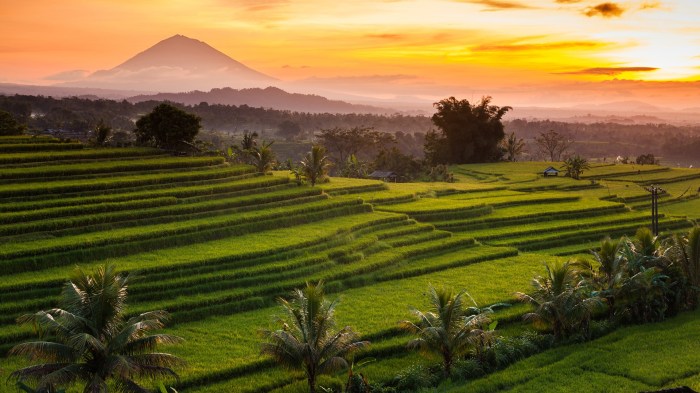
Jatiluwih Rice Terraces offer a breathtaking backdrop for photography and visual arts. The vast expanse of verdant terraces, framed by lush greenery and distant mountains, creates a captivating scene that invites exploration through the lens.
Techniques for Capturing Stunning Images
To capture the essence of Jatiluwih Rice Terraces, photographers and artists can employ a range of techniques:
- Utilize wide-angle lenses:Capture the sweeping panorama of the terraces, encompassing the vastness and depth of the landscape.
- Experiment with different perspectives:Explore the terraces from various angles, including aerial shots or close-ups of individual rice paddies, to reveal unique compositions and details.
- Play with lighting conditions:The golden hour, before sunrise or after sunset, casts a warm glow on the terraces, enhancing their beauty and creating dramatic images.
- Incorporate local elements:Include farmers working in the paddies, traditional houses, or other cultural elements to add a human touch and convey the local context.
Education and Research
Jatiluwih Rice Terraces hold immense educational and research value. They serve as a living laboratory for studying agriculture, ecology, and cultural heritage.
Educational Value
- The terraces showcase traditional farming techniques, water management systems, and the interdependence between humans and the environment.
- Students can learn about the history, culture, and social practices associated with rice cultivation in Bali.
- The terraces provide hands-on opportunities for students to engage in agricultural activities, such as planting, harvesting, and processing rice.
Research Opportunities
- The terraces offer a unique setting for research on sustainable agriculture, biodiversity conservation, and the impact of tourism on cultural heritage.
- Researchers can study the terraces’ role in carbon sequestration, water conservation, and soil erosion prevention.
- The terraces provide insights into the adaptation of traditional farming practices to changing environmental and economic conditions.
Promoting Sustainable Development
The Jatiluwih Rice Terraces serve as a model for sustainable development. They demonstrate the integration of agricultural practices with environmental conservation and cultural preservation.
The terraces have inspired educational programs that promote sustainable agriculture and environmental stewardship among local communities.
Conclusion

Jatiluwih Rice Terraces stand as a testament to the harmonious coexistence between nature and culture. Their unique characteristics, cultural significance, and environmental impact make them a treasure worthy of preservation and promotion.
Preserving Jatiluwih not only safeguards a cultural heritage but also ensures the well-being of the local community and the sustainability of the environment. Promoting the terraces through sustainable tourism practices can generate economic benefits while fostering cultural appreciation.
Potential for Further Research and Development
The Jatiluwih Rice Terraces offer ample opportunities for further research and development. Studies on the agricultural practices, water management techniques, and biodiversity within the terraces can contribute to advancements in sustainable agriculture and environmental conservation.
Exploring the cultural and historical aspects of Jatiluwih can deepen our understanding of traditional Balinese farming systems and the relationship between humans and the environment. Additionally, investigating the impact of tourism on the terraces can guide the development of sustainable tourism practices that minimize negative effects.
Final Thoughts
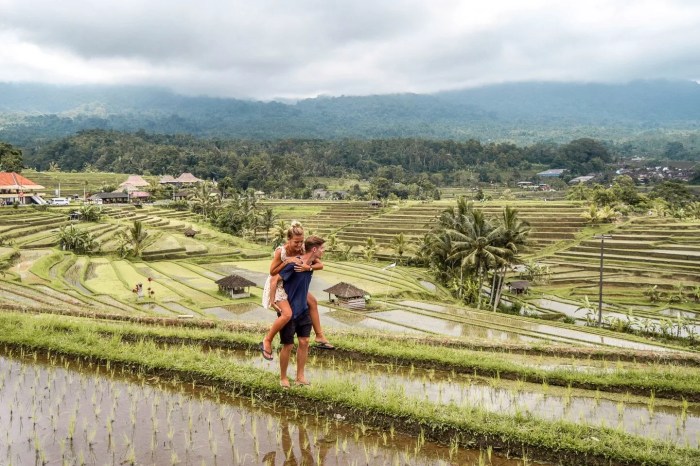
The Jatiluwih Rice Terraces are a beautiful and important part of Balinese culture. They are a UNESCO World Heritage Site, and they are a must-see for any visitor to Bali.
FAQ Section
Where are the Jatiluwih Rice Terraces located?
The Jatiluwih Rice Terraces are located in Bali, Indonesia.
How were the Jatiluwih Rice Terraces built?
The Jatiluwih Rice Terraces were built over centuries by the Balinese people.
What is the main crop grown on the Jatiluwih Rice Terraces?
The main crop grown on the Jatiluwih Rice Terraces is rice.
When is the best time to visit the Jatiluwih Rice Terraces?
The best time to visit the Jatiluwih Rice Terraces is during the dry season, from April to October.